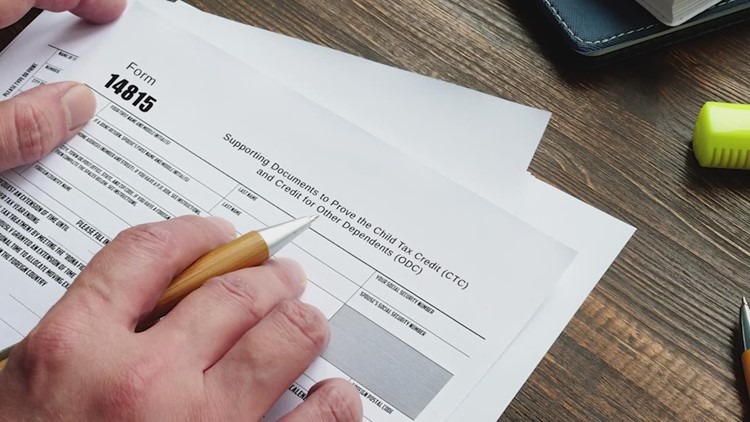As families prepare to file their 2021 income tax returns, child tax credit payments are top of mind for many. Millions of Americans received their final advance child tax credit payments in December, though some chose not to receive any payments in 2021.
The advance child tax credit passed as part of the American Rescue Plan in March 2021. From July to December, eligible families received monthly payments of up to $300 per month for each child under age 6 and up to $250 per month for each child ages 6 to 17. The qualifying age limit for child tax credit payments also increased from 16 to 17 years old as part of the American Rescue Plan.
Child tax credit payments have stopped in 2022 and Congress has not approved an extension.
The VERIFY team is breaking down what child tax credit recipients should know when filing their 2021 return this year.
THE SOURCES
- U.S. Department of the Treasury
- Internal Revenue Service (IRS)
- Mark Steber, chief tax information officer at Jackson Hewitt
- TurboTax
FAST FACTS
- What families who took advance child tax credit payment need to know: If you opted for the advance payments, you’ll still be able to claim a partial credit when filing your 2021 taxes this year. The IRS says families who received advance payments need to compare the advance payments they received in 2021 with the amount of child tax credit money they can claim on their tax return.
- What families who didn’t take advance child tax credit payments need to know: Eligible families who did not receive advance payments can claim the full Child Tax Credit on their 2021 tax return.
- Some families may be eligible for a higher credit amount: If a person’s income decreased or number of dependents increased in 2021, they may get an even bigger tax refund.
WHAT WE KNOW
Families were eligible for credits between $3,000 and $3,600 per child, depending on the child’s age
Eligible families receive $3,600 for each child under 6 years old and $3,000 for each child ages 6 to 16 under the American Rescue Plan’s expanded child tax credit. This is an increase from $2,000 per child in 2020, according to the US Department of the Treasury. The legislation also expanded eligibility to parents of 17-year-old children, who were not previously eligible for a child tax credit.
That breaks down to $300 per month for each child under 6 years old and $250 per month for each child 6 and above. Most families who got monthly payments are still owed half of the child tax credit in their 2021 tax return.
Families who took advance payments will receive partial credit on 2021 tax return
The payments families received between July and December were an advance of the child tax credit they would normally get when filing their tax returns. That means the amount of money eligible to be claimed as a tax credit decreases with every advance payment.
The IRS says families who received advance payments need to compare the advance payments they received in 2021 with the amount of child tax credit money they can properly claim on their tax return.
But even if you opted for the advance payments, you’ll still be able to claim a partial credit when filing your 2021 taxes this year.
Half the total credit ($1,800 for children under 6 years old and $1,500 for children over the age of 6) was paid in advance monthly payments from July through December 2021 and families can claim the other half when they file their 2021 tax return.
The IRS has started sending Letter 6419, which tells eligible parents how much advance child tax credit payments they received in 2021 and how many dependents were factored into the payments. People who get this letter should not throw it away, as it can help taxpayers or their tax professional prepare their 2021 return.
Families who didn’t receive advance payments can claim the money on their 2021 tax return
The IRS provided the option for people to unenroll from receiving advance Child Tax Credit Payments. Someone may have chosen to do this, for example, because the amount of tax they expected to owe would be greater than the refund on their 2021 tax return.
Eligible families who did not receive advance payments can claim the Child Tax Credit on their 2021 return to receive the full tax credit, the IRS says.
Families who received excess payments may need to repay the IRS
There may be some taxpayers who received excess advance child tax credit payments. Those people may need to repay some or all of that extra money, the IRS says on its website.
“If you received money from an advance child tax credit payment…and you didn't opt out and the child or the dependent is no longer yours – unless you meet a very narrow small bandwidth of safe harbor low-income exclusion – you have to pay that money back,” said Mark Steber, chief tax adviser for tax preparation service Jackson Hewitt.
Steber shared several scenarios in which someone may have to repay excess child tax credit money. First, a person who is in a shared custody situation may have received money in 2021 when their ex-spouse had custody of the child. Those who did not have custody of their child in 2021 needed to opt out, Steber added.
Someone could also have a very high income for 2021 and no longer qualify for child tax credit payments, but these are isolated cases since the income level is nearly up to $400,000 for married couples and $200,000 for those who are unmarried, Steber said.
Some families qualify for repayment protection
Some taxpayers who received excess payments and may need to repay the IRS could qualify for full repayment protection.
The IRS says on its website that families will not need to repay any excess amount if their main home was in the United States for more than half of 2021 and their modified adjusted gross income (AGI) is at or below the following amount based on the filing status on their 2021 tax return:
- $60,000 if they are married and filing a joint return or if filing as a qualifying widow or widower;
- $50,000 if they are filing as head of household;
- and $40,000 if they are a single filer or are married and filing a separate return.
The full repayment protection amount equals $2,000, multiplied by the following:
The number of qualifying children the IRS took into account in determining the initial estimate of advance child tax credit payments, minus the number of qualifying children properly taken into account in determining the allowed child tax credit amount on the person’s 2021 tax return.
Repayment protection may be limited for people who do not meet these qualifications. The IRS has more information about who does not qualify on its website.
Some families may be eligible for a higher credit amount when they file their 2021 tax return
TurboTax, a tax preparation service, wrote in a blog post that if a person’s income or number of dependents changed in 2021, they may also see a change in the tax refund they get this year.
Some may be eligible for a higher credit amount and will receive additional money on their 2021 tax return.
Some of these scenarios include adopting a child, having a child, fostering a child or having custody in 2021, Steber explained.
But it’s important to report these changes on your tax return.
“Those people will not automatically get money at all,” Steber added. “You have to put this on your tax return, you have to actually put it on the 8812 form or the information on your software to get it.”
More from VERIFY: No, the federal government is not taxing stimulus money













